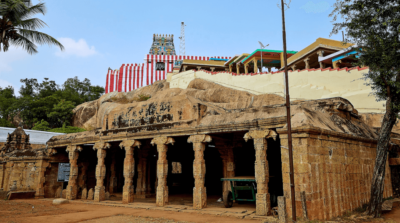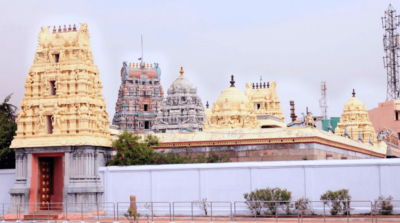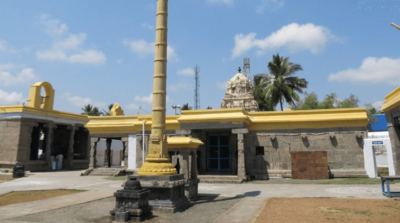Sikkal Singaravelan Temple
Sikkal Singaravelan or Singaravelar is known as Navaneetheswarar temple, located about five kilometres from Nagapattinam on the Nagapattinam-Tiruvarur route, is primarily a Saiva temple dedicated to Lord Shiva as Sri Navaneetheswara. However, the main deity worshipped is Lord Subrahmanya, known as Singaravelavar. According to legend, Sage Vasishta made a Sivalinga from butter, which became immovable after puja, leading to the name “Sikkal” (meaning “stuck” in Tamil). The temple has been worshipped by sages Vasishta, Viswamitra, the divine cow Kamadhenu, and Emperor Muchukunda of Deva Loka. Saints Sambandhar and Arunagirinathar have also sung in praise of the deity.
Sikkal Singaravelan Temple History
The Sikkal Singaravelavar Temple has a rich history steeped in legend and tradition. Located near Nagapattinam in Tamil Nadu, it is primarily a Shaiva temple dedicated to Lord Shiva as Śrī Navaneetheswara. However, the temple is more widely known for its connection to Lord Murugan, also known as Singaravelavar, who is the main deity worshipped here.
Legends and Historical Significance:
- Sage Vasishta’s Butter Lingam: The most prominent legend surrounding the temple involves Sage Vasishta. It is said that he made a Sivalinga out of butter (from the milk of the divine cow Kamadhenu) for his worship. After completing his worship, Vasishta found that the lingam had become immovable, or “stuck,” which led to the place being called “Sikkal” (meaning “stuck” in Tamil).
- Murugan and the Vel: According to another popular belief, Lord Muruga (Singaravelavar) received his divine spear (Vel) from his mother, Goddess Parvati, at Sikkal to defeat the demon Surapadman. The temple thus plays an important role in the legends surrounding the Skanda Shashti festival, as it is said that Murugan received the Vel at Sikkal the day before slaying the demon at Tiruchendur. A miracle occurs every year during the Skanda Shashti festival when the deity’s face is said to perspire after receiving the Vel, symbolizing his preparation for battle.
- Association with Muchukunda Cholan: Muchukunda Cholan, a historical figure tied to the Tiruvarur temple, is believed to have constructed the Sikkal temple as well. His devotion to both Shiva and Muruga further enhanced the temple’s importance.
- Connection to Vaishnavism: Interestingly, a nearby Vaishnava temple at Tirukkannankudi shares a similar legend involving Sage Vasishta, who offered worship to an image of Krishna made from butter. This intertwines the two temples in local tradition, highlighting the interplay between Shaivism and Vaishnavism in Tamil culture.
- Role of Vishnu: The temple also has a shrine dedicated to Vishnu, as it is believed that Lord Vishnu sought the blessings of Lord Shiva here before his mission to defeat the demon king Mahabali, leading to the construction of the Kola Vaamana Perumal shrine.
Temple Architecture and Inscriptions:
The temple has a seven-tiered rajagopuram (entrance tower) about 80 feet tall. Inside, the temple spans about two acres and contains shrines for multiple deities, including Velnedunganni (the goddess), Ganapati, Mahalakshmi, Nataraja, and Bhairava. There are also three sacred tanks: Ksheera, Gaya, and Lakshmi. The temple is decorated with various sculptures and paintings, particularly in the Kartikai Mandapam, which features depictions of Subramanya’s legends.
Inscriptions from the Chola and Vijayanagar periods found within the temple provide evidence of its antiquity and historical importance. These inscriptions record donations, temple renovations, and various religious activities, reflecting the continuous royal patronage the temple has received through the centuries.
Festivals and Religious Practices:
- Skanda Shashti: The most significant festival celebrated here is Skanda Shashti, during which Lord Muruga’s victory over Surapadman is reenacted. The festival involves the deity receiving the Vel from Goddess Parvati, followed by the enactment of Soorasamharam (the destruction of the demon Surapadman).
- Brahmotsavam: The annual brahmotsavam is celebrated in the Tamil month of Chittirai (April-May).
- Six daily worship services and numerous marriages take place in the temple’s kalyana mandapam.
The Sikkal temple’s history is a fascinating blend of mythology, royal patronage, and local tradition. Its association with Lord Muruga’s divine Vel, the immovable butter lingam, and the historical figure Muchukunda Cholan adds to its religious significance. With inscriptions dating back to the Chola and Vijayanagar periods, the temple stands as an important monument of South Indian temple architecture and devotion.
Sikkal Singaravelan Murugan pooja timing
| Pooja | Timing | Details |
|---|---|---|
| Ushathkalam | 5:30 AM – 6:00 AM | Early morning pooja to wake the deity. |
| Kalasanthi | 8:00 AM – 9:00 AM | Forenoon pooja with offerings to the deity. |
| Uchikalam | 11:30 AM – 12:00 PM | Midday pooja, including food offerings. |
| Sayaraksha | 5:30 PM – 6:30 PM | Evening pooja with rituals and adornment. |
| Irandam Kalam | 7:30 PM – 8:00 PM | Second evening pooja with additional offerings. |
| Ardhajama Pooja | 9:00 PM – 9:30 PM | Night pooja, marking the end of the day. |
These pooja times provide a regular schedule of worship for devotees visiting the Sikkal Singaravelavar Temple.
Sikkal Singaravelan Murugan Archanai and Fees:
| Type of Archanai | Description | Fees (Approx.) |
|---|---|---|
| Normal Archanai | Standard prayer offering for the deity. | ₹5 – ₹10 |
| Special Archanai | More elaborate pooja with specific offerings and chanting of the devotee’s name, gotra, etc. | ₹25 – ₹50 |
| Milk Abhishekam | Sacred bathing of the deity with milk. | ₹150 – ₹200 |
| Flower Garland Offering | Devotees can offer garlands to Murugan. | ₹100 – ₹200 |
| Skanda Shashti Archanai | Special pooja during the Skanda Shashti festival. | ₹500 and above |
| Vel Archanai | Pooja focused on Lord Murugan’s divine Vel (spear). | ₹200 – ₹300 |
Sikkal Singaravelan Temple 2024 Festivals
| Festival | Month | Details |
|---|---|---|
| Skanda Shashti | October – November | The most important festival. Celebrates Murugan’s victory over the demon Surapadman. Lord Murugan receives the Vel from Goddess Parvati, and the event culminates with Soorasamharam (the slaying of the demon). A miracle occurs where Murugan’s face is said to perspire after receiving the Vel. |
| Brahmotsavam | April – May (Chittirai) | Annual temple festival with processions, music, and various rituals, including the hoisting of the temple flag (Dwajarohanam). |
| Panguni Uthiram | March – April | A major festival celebrating the celestial marriage of Murugan with his consorts, Valli and Deivanai. |
| Kanda Sashti Kavasam Recital | Throughout the Year | Devotees recite the Kanda Sashti Kavasam, a famous Tamil hymn, during regular poojas and particularly during festival times. |
| Thai Poosam | January – February | Celebrates the day when Goddess Parvati gave Lord Murugan the divine spear (Vel) to destroy evil forces. |
| Vaikasi Visakam | May – June | Marks the birth of Lord Murugan. Special poojas and processions are organized. |
| Templei Krithigai | July – August | A significant festival dedicated to Murugan. Devotees perform special prayers and carry Kavadis (sacred offerings). |
| Karthigai Deepam | November – December | Festival of lights. Lamps are lit in and around the temple to honor Lord Murugan, who is associated with fire. |
- Skanda Shashti is the temple’s largest and most significant festival, celebrated for six days. The enactment of Soorasamharam (the slaying of demon Surapadman) is a major event.
- The Brahmotsavam is another key celebration, featuring colorful processions and a large turnout of devotees.
These festivals emphasize the temple’s cultural and religious significance, with each festival bringing unique rituals, processions, and ceremonies dedicated to Lord Murugan.





